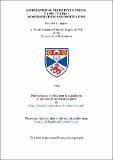Geographical mobility in Angus, c.1780 - c.1830 : modernisation and motivation
Abstract
The aim of this thesis is to investigate geographical mobility within Angus between 1780 and 1830 and to identify change and continuity in the levels, patterns and trends of movement. The relationships of mobility to modernising processes are examined in the social, urban and rural environments. Modernisation is seen as a set of forces which produced constraints and opportunities. Emphasis is placed on linking the individual to the wider social and economic context, although personal characteristics, motivations and perceptions are also seen as influential factors contributing to the decision-making process culminating in movement. The use of contemporary observations of individual writers furthers our understanding of views held in the past. Zelinsky's (1971) mobility transition model is used as a comparative tool and the early transitional stage is selected as the one most appropriate for the level of economic development of Angus during the study period. Patterns of mobility in Angus prove to be complex and made up of many different types of moves and movers. Important variations in patterns are linked in particular to gender, occupation, place of residence and motivation for movement. Spatial interaction between communities is analysed via courtship and marriage contacts. Directional bias reveals that the social environment was not separate from the economic environment. The urban areas, especially Dundee, were foci of development and population growth. Temporary and permanent mobility within the rural environment were at a high level, promoted by modernising processes. Country areas were not isolated but integrated economically with the urban centres. Stability existed in the countryside but changes in population distribution reveal a shift from a dispersed to a nucleated pattern. Processes promoting mobility changed over time and more people became mobile, although previous spatial patterns endured. Overall, geographical mobility patterns and trends in Angus between 1780 and 1830 show elements of continuity and change.
Collections
Items in the St Andrews Research Repository are protected by copyright, with all rights reserved, unless otherwise indicated.

